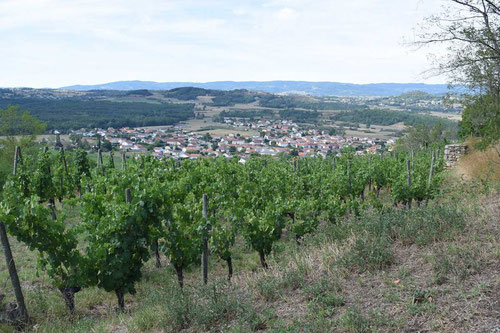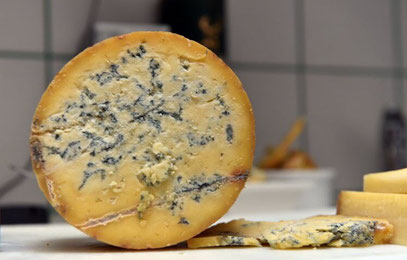Wine tourism in the Forez region

Here is a region we don't immediately think about when it comes to wine. Forez is a territory associated with the harsh weather and living conditions of the mountains, which theoretically don't allow the production of grapes and wine. Yet, there is a small vineyard in the Forez region, in the south of the Loire department: 150 hectares are planted at the foot of the Forez mountains, northwest of the city of Saint Étienne, and allow the production of AOC Côtes du Forez red wines. They are complemented by white wines produced under the name IGP Urfé. Although I didn't really fall in love with the vineyard landscapes of the region - I'll explain why in this article, the wines are really worth trying. It is their rarity and their originality that make them interesting.
Côtes du Forez, an AOC of the Loire vineyard

AOC Côtes du Forez belongs to the Loire vineyard. If the vineyards of this area do not overlook the "Loire River," as the locals call it - so as not to confuse it with the Loire department, where they live - the river is only a stone's throw away. The Forez vineyard is in fact the vineyard located furthest upstream of the Loire; it is also the closest to its spring, since the latter is only located about a hundred kilometers away. Here, the Loire offers a very different face from the one it shows in my native Touraine. It is its magnificent gorges that attract tourists, hikers and water sports enthusiasts.
The red wines of AOC Côtes du Forez

AOC Côtes du Forez, created in 2000, only produces varietal red wines. It shares with AOC Côte Roannaise, located a few dozen kilometers north, an indigenous grape variety which is only grown in the Loire department (42): Gamay Saint Romain takes its name from the village of Saint-Romain-La-Motte, located in the heart of the Côte Roannaise vineyard. This grape variety is a cousin of Gamay Noir, which is planted in the Beaujolais region. Its small, tight bunches produce a fragrant, fruity and spicy juice with notes of white pepper. In the Forez region, it is planted both on granite soils (like in the Côte Roannaise) and on basalt soils, called "volcanic" soils by local vinegrowers. On these two types of terroirs, Gamay Saint Romain expresses itself differently. I personally have a preference for the wines made from basalt soils, which reveal more finesse and a silkier texture on the palate.
The white wines produced in the Forez region

The Forez region shares an IGP (Geographically Protected Indication) with neighboring AOC Côte Roannaise. IGP Urfé, which spreads around 150 communes in the Loire department, allows the production of white wines with Chardonnay, Viognier, Aligoté, Pinot Gris, Marsanne, Roussanne and Gewurtzraminer. Some vinegrowers have also planted grape varieties such as Chenin Blanc or Riesling, which they use to make "Vin de France".
Where can you see the Forez vineyard?

The 150 hectares of vineyard are scattered across 17 villages located roughly between the city of Saint Étienne and the town of Montbrison. So there are no seas of vines and no breathtaking
vineyard landscapes in this part of France. The vineyard is planted between fields and meadows. I was expecting a very green environment but the region's continental climate means that summers
are hot and dry. The vineyard, planted between 400 and 550 meters above sea level, also experiences a marked Foehn effect around Montbrison, which is the least rainy area of the department. I was
really surprised by the yellow and dried out landscapes.
In Champdieu, a beautiful hike around the Madone hill allows you to discover grapevines of Gamay Saint Romain and Roussanne. Once you reach the statue of the Virgin at the top of the hill, you
can enjoy a beautiful 360-degree view of the surrounding plain. At the start of the climb, a dovecote satnds in the middle of a plot of vines: bird droppings were formerly used to fertilize the
vineyard.
In Saint-Romain-le-Puy, climbing to the priory allows you to hike between the vines planted on the slopes of the hill. From there, the view on the village and the valley is amazing.
Verdier-Logel winery in Marcilly-le-Châtel
It was thanks to this family estate, which is a reference in the Côtes du Forez vineyard, that I tasted the region's wines for the first time and discovered that Viognier was produced in the Loire vineyard. In spring 2021, in a wine shop in the city of Le Mans, I actually found some bottles of Viognier and Pinot Gris wines produced under the name IGP Urfé by the Verdier Logel family. I decided to contact them during my stay in the Forez region and had the opportunity to enjoy a wine tasting at the winery. This estate, founded in the early 1990s, converted to organic grape-graowing 5 years after its creation. With grapes grown either on granite or basalt, the Verdier Logel family produce 5 very fruity and spicy Côtes de Forez wines. Pinot Gris also allows them to produce two wines, from each of the two types of soils. Finally, other grape varieties are grown on the estate to make Vin de France: Gewurtzraminer and Riesling for the white wines, Syrah and Malbec for the red wines. The range is therefore very original, and is sold at very low prices for organic wines.
What local specialties to go with the Forez wines?
Fourme de Montbrison

The town of Montbrison is located in the Loire department, 40 km northwest of the city of Saint Étienne and in the heart of the Côtes du Forez vineyard. A cheese with an Appellation of Controlled Origin is produced there: AOC Fourme de Montbrison is much less known than AOC Fourme d'Ambert, due to a more confidential production. The cheese is yellower, its texture is a little firmer and less creamy, and it is slightly fuller-bodied, while being less powerful than a Bleu d'Auvergne or a Bleu des Causses cheese.
Chocolate black pudding




Write a comment